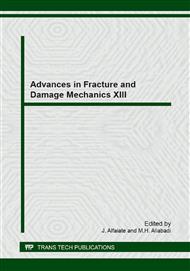p.381
p.385
p.389
p.393
p.397
p.401
p.405
p.409
p.413
Investigation on Compressive Strength after Impact Damage of Carbon/Epoxy Laminate
Abstract:
Development of the Korean small scale aircraft (KC-100) has been carried out by KAI (Korea Aerospace Industry Ltd.) for the BASA(Bilateral Aviation Safety Agreement) program with FAA. The KC-100 aircraft adopted the environmental friendly whole composite structure concept due to low fuel consumption owing to its light weight. However the composite structure has a disadvantage. They are very weak against impact damage due to FOD (Foreign Object Damage). This study is to investigate the residual compressive strength of the carbon/epoxy fabric and UD (Unidirectional prepreg tape) laminate due to impact damages. This residual compressive strength test follows fully the ASTM standard test procedure. Experimental investigation results reveal the residual strengths and the damage mode and size of impact damage specimens. Through these tests, it is found that the residual strength of the impact damage specimens is greatly reduced in comparison to the undamaged specimens depending on increase of both the indentation depth and the impact energy. The size and shape of damage zone greatly affects the reduction of the compressive strength.
Info:
Periodical:
Pages:
397-400
Citation:
Online since:
September 2014
Authors:
Keywords:
Price:
Сopyright:
© 2015 Trans Tech Publications Ltd. All Rights Reserved
Share:
Citation:


